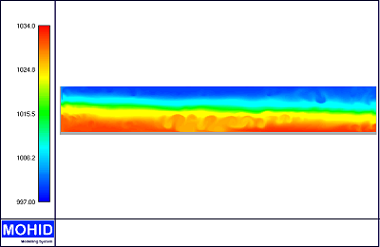Hydrodynamics
The “hydrodynamic” module of the Mohid system is able to simulate the flow in water masses where the flow velocity is lower than the celerity of the pressure wave.
This module has been used to simulate hydrodynamic processes in oceans (Atlantic NE and Atlantic SW), in coastal areas (several areas along the Portuguese and Brazil coasts), in more than 30 estuaries and lagoons (European, African and Brazilian estuaries and lagoons) and in water dams (south of Portugal).
All these study areas have complex flows and intense ecological activity with a strong relation with hydrodynamic processes. The “hydrodynamic” module aims to be a numerical tool oriented to help understanding biogeochemical processes and resolve ecological problems associated with human activity.
Approximations
Numerical Characteristics
Main characteristics |
|---|
| Spatial discretisation | Finite volumes |
| Horizontal Grid | Orthogonal |
| Vertical Grid | Generic coordinates |
| Computation points distribution | Arakawa C |
| Time discretisation | ADI – 2D mass balance; explicit – horizontal momentum; implicit – vertical momentum |
Forces discretisation |
|---|
| Forces computed explicitly | Coriolis, tide potential, baroclinic pressure gradient, atmosphere forcing (wind stress and pressure), horizontal advection and diffusion of momentum |
| Forces computed implicitly | Barotropic pressure gradient, bottom friction, vertical advection and diffusion of momentum |
| Baroclinic pressure spatial discretisation | Cartesian referential (or z level referential) |
| Horizontal advection of momentum |
- Upwind 1º order
- TVD (upwind 1º order + central differences or higher order upwind)
|
| Vertical advection of momentum | Hybrid (upwind + central differences) |
| Diffusion of momentum | Central differences |
Boundary conditions |
|---|
Barotropic pressure gradient:
- Water level
- Barotropic velocity
|
- Imposed
- Null gradient
- Cycle
- Radiation (Flather, 1976)
- Radiation (Blumberg & Kantha, 1985)
- Flow relaxation
The last three boundary conditions use a reference solution that can be imposed using two methodologies:
- Input data: the solution is imposed as model input data
- One way nesting: the solution is compute by a courser grid model
|
Baroclinic pressure gradient:
- Baroclinic velocity
- Temperature and salinity
|
- Imposed
- Null gradient
- Radiation (Marchesiello et al., 2001):
- Celerity constant
- Celerity according to Orlansky (1976)
- Flow relaxation:
- Input data
- One way nesting
|
| Coriolis, horizontal advection and diffusion of momentum:
|
- Imposed null value
- Null gradient
|
Turbulence |
|---|
|
Horizontal
|
|
|
Vertical
|
- Constant
- Coupled with GOTM. Traditional as well as state-of-the-art parameterisations (e.g. k-ε, k-Ω) for vertical turbulent mixing – see http://www.gotm.net/
|
| 3D
|
Smagorinsky 3D
|
Waves |
|---|
|
Solution imposed via input files
|
- Variable in space constant in time ASCII
- Variable in space and time HDF5
|
|
Fetch type model
|
|
|
Two way runtime coupling with SWAN
|
The user can run MOHID and SWAN together. In run time MOHID updates the sea level, velocities and bathymetry while SWAN updates the wave properties (e.g. Hs, Tp, Dir., gradients of radiation stresses).
|
 Kelvin-Helmholtz instability in a water basin - animation 2.2 MB
Kelvin-Helmholtz instability in a water basin - animation 2.2 MB


